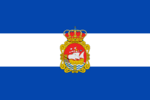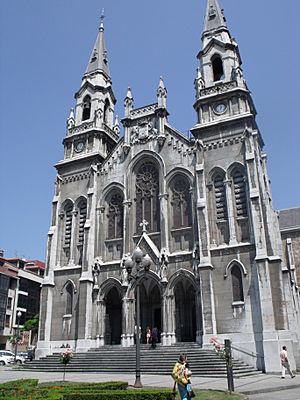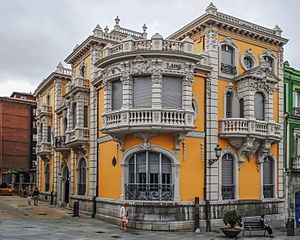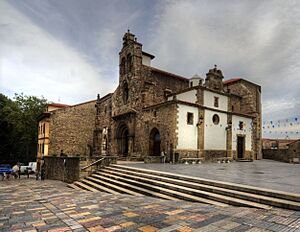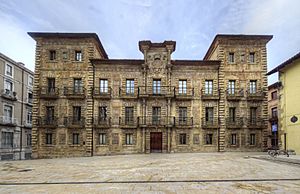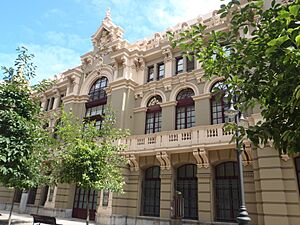Avilés facts for kids
Quick facts for kids
Avilés
|
|||
|---|---|---|---|

San Francisco street
|
|||
|
|||
| Country | Spain | ||
| Autonomous community | Asturias | ||
| Comarca | Avilés | ||
| Capital | Avilés | ||
| Area | |||
| • Total | 26.81 km2 (10.35 sq mi) | ||
| Elevation | 139 m (456 ft) | ||
| Population
(2018)
|
|||
| • Total | 78,715 | ||
| • Density | 2,936.0/km2 (7,604.3/sq mi) | ||
| Demonym(s) | avilesino | ||
| Time zone | UTC+1 (CET) | ||
| • Summer (DST) | UTC+2 (CEST) | ||
| Postal code |
33401 to 33403
|
||
| Official language(s) | Spanish | ||
Avilés is a lively town in Asturias, a region in northern Spain. It is one of the three main cities in the Principality of Asturias, along with Oviedo and Gijón.
The town is built on flat land, part of which used to be covered by the sea. It is surrounded by small hills, none taller than 140 meters. Avilés is located on the Avilés estuary, which is an inlet of the sea. This location makes it a very important national seaport.
Avilés is known as an industrial city, meaning it has many factories. It is also close to beautiful beaches like Salinas. The city has important old churches, such as St. Thomas of Canterbury. Avilés also has cool cultural places. These include the Palacio Valdés Theatre and the Oscar Niemeyer International Cultural Centre.
Contents
Discovering Avilés: A Look at Its Past
How Avilés Got Its Name
The name "Avilés" is very old. It probably comes from a Roman landowner named Abilius. This person might have been a Roman or a Germanic warrior who settled in the area long ago.
Important Moments in Avilés' History
People have lived in the Avilés area since the Stone Age. This has been shown by old tools and remains found there.
The first official record of Avilés is from the year 905. At that time, King Alfonso III of León gave two churches to the town. During the Middle Ages, Avilés was one of the most important ports on the Bay of Biscay. It traded a lot with French ports, mostly selling salt.
In the Middle Ages, Avilés had two main parts. One was Sabugo, where the fishermen lived. The other was La Villa, where important families lived. These two parts were separated by a small water channel. La Villa was protected by strong walls, showing how important it was for trade and defense.
In 1479, the Catholic Monarchs gave Avilés the right to hold a free market every Monday. This market still happens today! Avilés was also important for building ships. Local sailors even helped the Castilian army conquer Seville. This event is shown on Avilés's coat of arms.
Avilés is the birthplace of Pedro Menéndez de Avilés. He was a soldier who explored Florida in the 1500s. In 1565, he founded San Agustín, which is now St. Augustine, Florida. This was the first European town in what is now the United States that has been lived in continuously. Today, St. Augustine and Avilés are sister cities. Another famous person born in Avilés was Juan Carreño de Miranda. He was a painter for King Charles II of Spain.
In the 1800s, the Avilés estuary was cleaned up and made ready for ships again. The water channel that divided the town was filled in. This joined the two parts, Sabugo and La Villa, together. The old medieval wall was taken down in 1818, and the city started to grow.
In the 1900s, Avilés grew a lot because large factories were built there. In 1953, work began on ENSIDESA, a big steel mill. Other companies like Cristalería Española and ENDASA also came. These factories made Avilés one of Spain's main industrial centers.
Today, Avilés is changing. It is focusing on new industries, especially cultural tourism. The city wants to bring back its old charm and history.
Culture and Fun in Avilés
Amazing Buildings and Old Churches
Avilés has many interesting buildings to see:
- Thomas of Canterbury church: This church is very old, from the 13th century.
- Church of Saint Nicholas of Bari: Built in the 12th-13th century, it has a Romanesque style.
- Palacio de Valdecarzana: This is the only example of a medieval palace in the town.
- Palacio de Llano Ponte: Built between 1700 and 1706.
- Baroque Palacio de Camposagrado: This palace has a strong wall on its north side to protect against English pirates.
- Capilla de los Alas: A 14th-century tomb with a mix of Romanesque and Gothic styles.
- Old church of Sabugo: Another old church from the 13th century.
- Palacio de Balsera: A palace built in a Modernist style.
- Palacio Valdés Theatre: A beautiful theatre built in a Neobaroque style.
Museums and Art Spots
Avilés has cool places to learn and see art:
- Museum of Avilés Urban History: Learn about the city's past.
- Black Pottery Museum: See unique pottery.
- Alfercam Museum: This museum has a mix of musical instruments from around the world and old cars.
- Casa de Cultura: This building has a public library, an art gallery, and places to read and study.
- CMAE - Centro municipal de arte y exposiciones: An art and exhibition center near the town center.
- Oscar Niemeyer International Cultural Centre: This amazing building was designed by the famous Brazilian architect Oscar Niemeyer. It attracts many important people, including Nobel Prize winners, musicians, and actors.
Sculptures Around Town
You can find many interesting sculptures in Avilés:
- In El Muelle park, look for the Pedro Menendez sculpture and La foca (the seal).
- The Ruta del acero (Steel Route) has sculptures along the Avilés estuary.
- There's also an Avilés sculpture and others like Marta y María.
Fun Festivals and Traditions
Avilés has many exciting celebrations throughout the year:
- Autumn:
- The Feast of the Amagüestu is a traditional autumn celebration.
- Winter:
- The Antroxu (Carnival) is a big event. It includes the famous Galiana Street International and Fluvial Descent.
- Spring:
- The Feast of the Bollo celebrates a traditional cake called bollo.
- Lunch in the street (Comida en la Calle) is a fun event where everyone eats together outdoors.
- The LGBTIQ+ Asturian Cinema Festival celebrates diverse films.
- Summer:
- The Celsius 232 is a festival for terror, fantasy, and science fiction books.
- The Interceltic Festival of Avilés brings people from all Celtic nations together. You'll see people from places like Ireland, Scotland, and Brittany.
- The Feast of Saint Augustine celebrates Avilés's patron saint.
- La Mar de Ruido is a cool rock music festival.
Other Festivals to Enjoy
- Avilés International Cinema and Architecture Festival: A festival about movies and building design.
- Beer Festival: Enjoy different kinds of beer.
- Avilés Acción Film Festival: An international festival for short films.
- Sol Celta: A festival organized from Sol Street.
- IndieGo Alley Festival: A festival for creative films and music that happens for one evening.
Avilés Weather
Avilés has an oceanic climate. This means it has warm summers with a mix of cloudy and sunny days. Winters are mild, with a good amount of rain and wind. Sometimes it can even snow at sea level. The temperature rarely drops below freezing (0°C) or goes above 30°C. Summers are cooler than in many other parts of Spain because of the city's location by the sea.
Avilés' Economy
The Port of Avilés is a very important part of the city's economy. It handles many types of goods, like large amounts of raw materials and packaged items. It also has facilities for fishing boats and leisure boats.
Local Areas (Parishes)
Avilés is divided into several smaller areas called parishes:
- Avilés
- Corros
- Entreviñas
- Laviana
- Miranda
- Valliniello
Famous People from Avilés
Many notable people were born in Avilés:
- Horacio Álvarez (1881–1936), a politician, lawyer, and journalist.
- Kily Álvarez (born 1984), a footballer.
- Sergio Álvarez (born 1992), another footballer.
- Iván Candela (born 1978), a retired footballer.
- Juan Carreño de Miranda (1614–1685), a famous painter.
- Yago Lamela (1977–2014), an athlete.
- Pedro Menéndez de Avilés (1519–1574), a famous admiral and explorer who founded St. Augustine, Florida.
- Esteban de las Alas, who was a governor of Florida.
- Juan Treviño de Guillamas (died before 1636), who was also a governor of Spanish Florida and Venezuela.
Sister Cities
Avilés has special connections with other cities around the world:
 St. Augustine, Florida, United States
St. Augustine, Florida, United States Saint-Nazaire, France
Saint-Nazaire, France Laayoune, Morocco
Laayoune, Morocco Cárdenas, Cuba
Cárdenas, Cuba
See Also
 In Spanish: Avilés para niños
In Spanish: Avilés para niños


